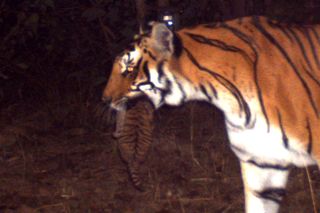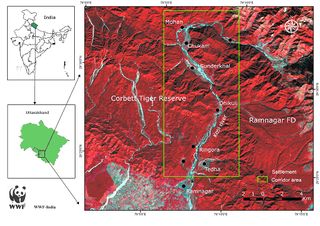
Camera Traps Spot Mother Tiger and Cubs in India

A few weeks after conservationists spotted tigers crossing a river in northern India firsthand, a field team has collected camera-trap photo evidence of the area being used by 13 tigers, including a mother and her cubs.
Having this information will help officials and conservationists learn how to better protect the tigers and how the big cats use the area.
A team working with the conservation group WWF witnessed a male tiger crossing the Kosi River in an area called the Terai Arc Landscape in October 2011 and were able to take pictures of the rare sight.
The river divides the Corbett Tiger Reserve from the Ramnagar Forest Division to its east. The area acts as a wildlife corridor, or link between habitats for important species that can be cordoned off into smaller populations by development.

New tiger pictures
The All India Tiger Estimation, a tiger census conducted in 2010, estimated a density of 15 tigers per 100 square kilometers (about 39 square miles) — the highest outside a tiger reserve in all of India. Currently, the tiger populations in the landscape are patchy and are probably linked to each other through wildlife corridors in the landscape.
WWF-India began a study using camera traps later that year in the Kosi range to identify tigers living along the periphery of the reserve near the river. The aim was to use the images the traps took to estimate tiger densities and to see how well the corridor functioned for the big cats. [Camera Trapped: Photos of Wonderful Wildlife]
Sign up for the Live Science daily newsletter now
Get the world’s most fascinating discoveries delivered straight to your inbox.
"This study is the first of its kind in this landscape and generates baseline data for the Ramnagar Forest Division and the functionality of the Kosi River, which will help in their long-term conservation," said WWF-India's tiger coordinator, Joseph Vattakaven.
Recently, the camera traps snapped images of a tigress with her two sub-adult cubs in Terai West FD feeding on a domestic cow. In January 2012, the same tigress was photographed carrying an approximately 1-month-old cub in her mouth, farther south in the Kosi corridor.
Human-animal conflict
The villager whose cow the tigress and her cubs killed was compensated under the WWF-India funded Interim Relief Scheme, which prevented a retaliatory strike against the tigers, an important problem facing their continued conservation.

The Corbett Tiger Reserve has one of the highest rates of cattle kills in the world. An average of 1,000 cattle kills per year was documented by WWF-India's team in the five-year period between January 2006 and December 2010. Overall, human-tiger conflict in the area has been on the rise.
"Human-animal interaction is frequent owing to movement of humans in forests as well as the expansion of tourism in the area, particularly the many tourist resorts that have sprung up here in the recent past," said KD Kandpal, landscape coordinator for the Terai Arc Landscape. "If unchecked, the resorts mushrooming in the area will choke the corridor and block the free movement of tigers through it. If the tiger in India is to be saved for posterity, the Kosi River tiger corridor needs to be protected at all costs."
This story was provided by OurAmazingPlanet, a sister site to LiveScience.

